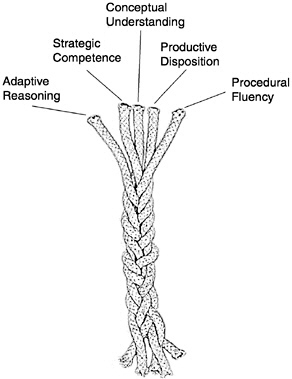An odds-and-ends Workbook¶
This workbook is still very much under construction.
The Five Strands of Proficiency¶
This was an important study commissioned by the President in the USA. It looked at what was needed for students to become proficient in maths.
But it is also an amazingly accurate fit for what we need for proficiency in Computer Science, or even for proficiency in playing Jazz!

Procedural Fluency: Learn the syntax. Learn to type. Learn your way around your tools. Learn and practice your scales. Learn to rearrange formulae.
Conceptual Understanding: Understand why the bits fit together like they do.
Strategic Competence: Can you see what to do next? Can you formulate this word problem into your notation? Can you take the music where you want it to go?
Adaptive Reasoning: Can you see how to change what you’ve learnt for this new problem?
- A Productive Disposition: We need that Can Do! attitude!
- You habitually think it is worthwhile studying this stuff.
- You are diligent and disciplined enough to grind through the tough stuff, and to put in your practice hours.
- You develop a sense of efficacy — that you can make things happen!
Check out http://mason.gmu.edu/~jsuh4/teaching/strands.htm, or Kilpatrick’s book at http://www.nap.edu/openbook.php?isbn=0309069955
Sending Email¶
Sometimes it is fun to do powerful things with Python — remember that part of the “productive disposition” we saw under the five threads of proficiency included efficacy — the sense of being able to accomplish something useful. Here is a Python example of how you can send email to someone.
1 2 3 4 5 6 7 8 9 10 11 12 13 14 15 16 17 18 19 20 21 22 23 24 25 26 27 28 | import smtplib, email.mime.text
me = 'joe@my.org.com' # put your own email here
fred = 'fred@his.org.com' # and fred's email address here
your_mail_server = 'mail.my.org.com' # Ask your system administrator
# Create a text message containing the body of the email.
# You could read this from a file, of course.
msg = email.mime.text.MIMEText("""Hey Fred,
I'm having a party, please come at 8pm.
Bring a plate of snacks and your own drinks.
Joe""" )
msg['From'] = me # add some headers to the message object
msg['To'] = fred
msg['Subject'] = 'Party on Saturday 23rd'
# create a connection to your mail server
svr = smtplib.SMTP(your_mail_server)
response = svr.sendmail(me, fred, msg.as_string()) # send the message
if response != {}:
print("Sending failed for ", response)
else:
print("Message sent.")
svr.quit() # close the connection
|
In the context of the course, notice how we use the two objects in this program: we create a message object on line 9, and set some attributes at lines 16-18. We then create a connection object at line 23, and ask it to send our message.